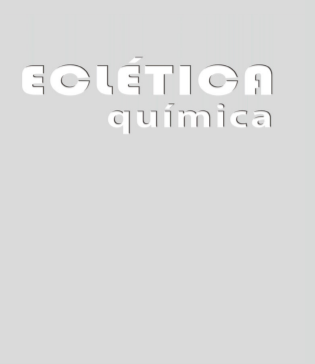Abstract
Laboratories consume great amounts of hazardous chemicals substances and consequently generate wastewater containing them, for example formaldehyde. This substance is widely utilized to preserve biological samples generating many liters of this residue every year. The present work proposes the use of the photo-Fenton process to treat formaldehyde wastewater using sunlight irradiation. Some aspects were investigated such as the iron source, sample and hydrogen peroxide concentration and also the use of stirred systems. The use of ferrioxalate (0.5 mmol L-1) improved the efficiency of the process in relation to the use of iron nitrate, while at least 1.0 mol L-1 H2O2 is necessary to treat the sample of the 500 mg C L-1. Under these conditions, every formaldehyde detectable was degradeted and 89% of the dissolved organic carbon was removed in two hours of exposure to sunlight. These results are satisfaction considerate for São Paulo State Environmental Agency.
References
M. Casanova, K. T. Morgan, E. A. Gross, O. M. Moss, H. D. H. Heck, Fund. Appl. Toxicol. 23(4) (1994) 525.
O. Merk, G. Speit, Environ. Mol. Mutagen. 33 (2) (1999) 167.
G. Speit, O. Merk, Mutagenesis. 17 (2002) 183.
International Agency OF Research in Cancer (IARC), 88 (2004) 2.
Companhia Estadual de Tecnologia de Saneamento Básico e de Defesa do Meio Ambiente (CETESB), 1976. Decreto
Estadual n° 8.468/76.
Environmental Protection Agency (EPA). 71(126) (2006) 37743.
Z. Lu, W. Hegemann, Wat. Res. 32 (1) (1998) 209.
P. Kajitvichyanukul, M. C. Lu,C. Liao, W. Wirojanagud, T. Koottatep, J. Haz. Materials B 135 (2006) 337.
S. Mourato, E. Ozdemiroglu, V. Foster, Environ. Sci. Technol. 34(8) (2000) 1456.
P. Mazellier, B. Sulzberger, Environ. Sci. Technol. 35(16) (2001) 3314.
R. F. P. Nogueira, M. C. Oliveira, W. C. Paterlini, Talanta, 66(1) (2005) 86.
A. G. Trovó, R. D. Villa, R. F. P. Nogueira, Quim. Nova 28(5) (2005) 847.
J. Bandara, C. Morrison, J. Kiwi, C. Pulgarin, C. Peringer, J. Photochem. Photobiol. A: Chem. 99(1) (1996) 57.
Y. Wang, D. Zhao, W. Ma, C. Chen, J. Zhao, Environ. Sci. Technol. 42(16) (2008) 6173.
J. Ma, W. Song, C. Chen, W. Ma, J. Zhao, Y. Tang, Environ. Sci. Technol. 39(15) (2005) 5810.
R. F. P. Nogueira, D. F. Modé, Eclet. Quim., 27 (2002) 169.
J. J. Pignatello, Environ. Sci. Technol., 26 (1992) 944.
R. G. Zepp, B. C. Faust, J. Hoigne, Environ. Sci. Technol. 26 (1992) 313.
A. P. Murphy, W. J. Boegli, M. K. Price, C. D. Moody, C.D, Environm. Sci. Technol., 23 (1989) 166.
R. F. P. Nogueira, M. R. A. Silva, M.R.A., A. G. Trovó,Sol Energy, 79(4) (2005) 384.
P. Kajitvichyanukul, M. C. Lu, C. Liao, W. Wirojanagud, T. Koottatep, J. Haz. Materials 135(2) (2006) 337.
C. G. Hatchard, C. A. Parker, Proc. R. Soc. (London) A 235 (1956) 518.
R. F. P. Nogueira, A. G. Trovo, D. F. Modé, Chemosp., 48(4) (2002) 385.
J. P. Logde, Methods of air sampling and analysis, Lewis, USA, 3rd ed., (1989).
A. Safarzadeh-Amiri, J. R. Bolton, S. R. Carter, Sol. Energy. 56 (1996) 439.
B. C. Faust, J. Hoigné, Atmos. Environ. 24(A) (1990) 79.
C. A. Emilio, W. F. Jardim, M. F. Litter, H. D. Mansilla, J. Photochem. Photobiol. A 151 (2002) 121.
O. Legrini, E. Oliveros,A. M. Braum, Chem. Rev. 93(2) (1993) 671.
N. S. Pereira, M. Zaiat.J. Haz. Mat. 163 (2) (2009) 777.
J. Aranã, J. L. Martinez Nieto, J. A. H. Melian, J. M.D.nRodríguez, O. G. Dias, J. P. Pena, J.P., O. Bergasa, O., C. Alvarez, C., J. Mendez, J., Chemosp., 55 (2004) 893.

This work is licensed under a Creative Commons Attribution 4.0 International License.
Copyright (c) 2018 Eclética Química Journal





